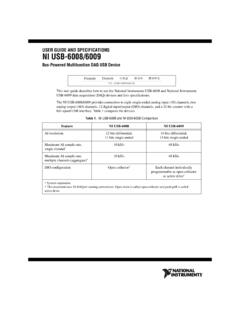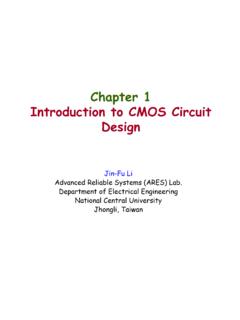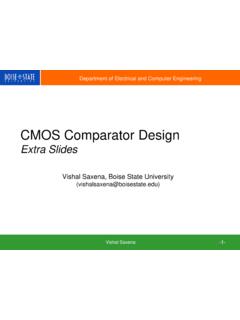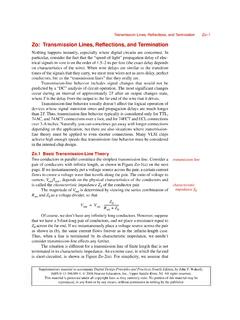Transcription of Lecture 19: SRAM
1 Lecture 19: SRAM. Outline Memory Arrays SRAM Architecture SRAM Cell Decoders Column Circuitry 19: SRAM cmos vlsi design 4th Ed. 2. Memory Arrays 19: SRAM cmos vlsi design 4th Ed. 3. Array Architecture 2n words of 2m bits each If n >> m, fold by 2k into fewer rows of more columns Good regularity easy to design Very high density if good cells are used 19: SRAM cmos vlsi design 4th Ed. 4. 6T SRAM Cell Cell size accounts for most of array size Reduce cell size at expense of complexity 6T SRAM Cell Used in most commercial chips Data stored in cross-coupled inverters Read: Precharge bit, bit_b Raise wordline Write: Drive data onto bit, bit_b Raise wordline 19: SRAM cmos vlsi design 4th Ed.
2 5. SRAM Read Precharge both bitlines high Then turn on wordline One of the two bitlines will be pulled down by the cell Ex: A = 0, A_b = 1. bit discharges, bit_b stays high But A bumps up slightly Read stability A must not flip N1 >> N2. 19: SRAM cmos vlsi design 4th Ed. 6. SRAM Write Drive one bitline high, the other low Then turn on wordline Bitlines overpower cell with new value Ex: A = 0, A_b = 1, bit = 1, bit_b = 0. Force A_b low, then A rises high Writability Must overpower feedback inverter N2 >> P1. 19: SRAM cmos vlsi design 4th Ed. 7. SRAM Sizing High bitlines must not overpower inverters during reads But low bitlines must write new value into cell 19: SRAM cmos vlsi design 4th Ed.
3 8. SRAM Column Example Read Write 19: SRAM cmos vlsi design 4th Ed. 9. SRAM Layout Cell size is critical: 26 x 45 (even smaller in industry). Tile cells sharing VDD, GND, bitline contacts 19: SRAM cmos vlsi design 4th Ed. 10. Thin Cell In nanometer cmos . Avoid bends in polysilicon and diffusion Orient all transistors in one direction Lithographically friendly or thin cell layout fixes this Also reduces length and capacitance of bitlines 19: SRAM cmos vlsi design 4th Ed. 11. Commercial SRAMs Five generations of Intel SRAM cell micrographs Transition to thin cell at 65 nm Steady scaling of cell area 19: SRAM cmos vlsi design 4th Ed.
4 12. Decoders n:2n decoder consists of 2n n-input AND gates One needed for each row of memory Build AND from NAND or NOR gates Static cmos Pseudo-nMOS. 19: SRAM cmos vlsi design 4th Ed. 13. Decoder Layout Decoders must be pitch-matched to SRAM cell Requires very skinny gates 19: SRAM cmos vlsi design 4th Ed. 14. Large Decoders For n > 4, NAND gates become slow Break large gates into multiple smaller gates 19: SRAM cmos vlsi design 4th Ed. 15. Predecoding Many of these gates are redundant Factor out common gates into predecoder Saves area Same path effort 19: SRAM cmos vlsi design 4th Ed.
5 16. Column Circuitry Some circuitry is required for each column Bitline conditioning Sense amplifiers Column multiplexing 19: SRAM cmos vlsi design 4th Ed. 17. Bitline Conditioning Precharge bitlines high before reads Equalize bitlines to minimize voltage difference when using sense amplifiers 19: SRAM cmos vlsi design 4th Ed. 18. Sense Amplifiers Bitlines have many cells attached Ex: 32-kbit SRAM has 128 rows x 256 cols 128 cells on each bitline tpd (C/I) V. Even with shared diffusion contacts, 64C of diffusion capacitance (big C). Discharged slowly through small transistors (small I).
6 Sense amplifiers are triggered on small voltage swing (reduce V). 19: SRAM cmos vlsi design 4th Ed. 19. Differential Pair Amp Differential pair requires no clock But always dissipates static power 19: SRAM cmos vlsi design 4th Ed. 20. Clocked Sense Amp Clocked sense amp saves power Requires sense_clk after enough bitline swing Isolation transistors cut off large bitline capacitance 19: SRAM cmos vlsi design 4th Ed. 21.

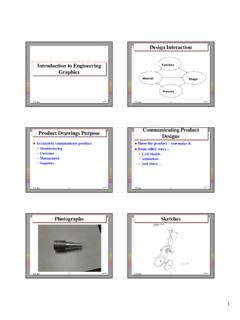
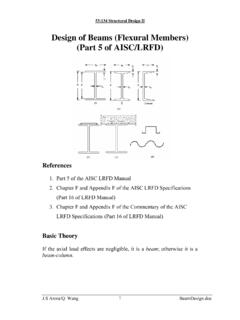
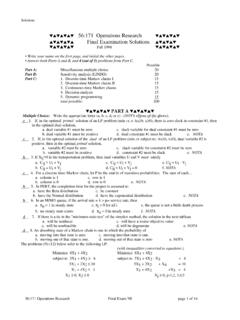
![Corrosion Protection.ppt [Read-Only] - University of Iowa](/cache/preview/1/c/f/9/2/e/d/5/thumb-1cf92ed5cf903dbf2b6cd3a840081a01.jpg)


